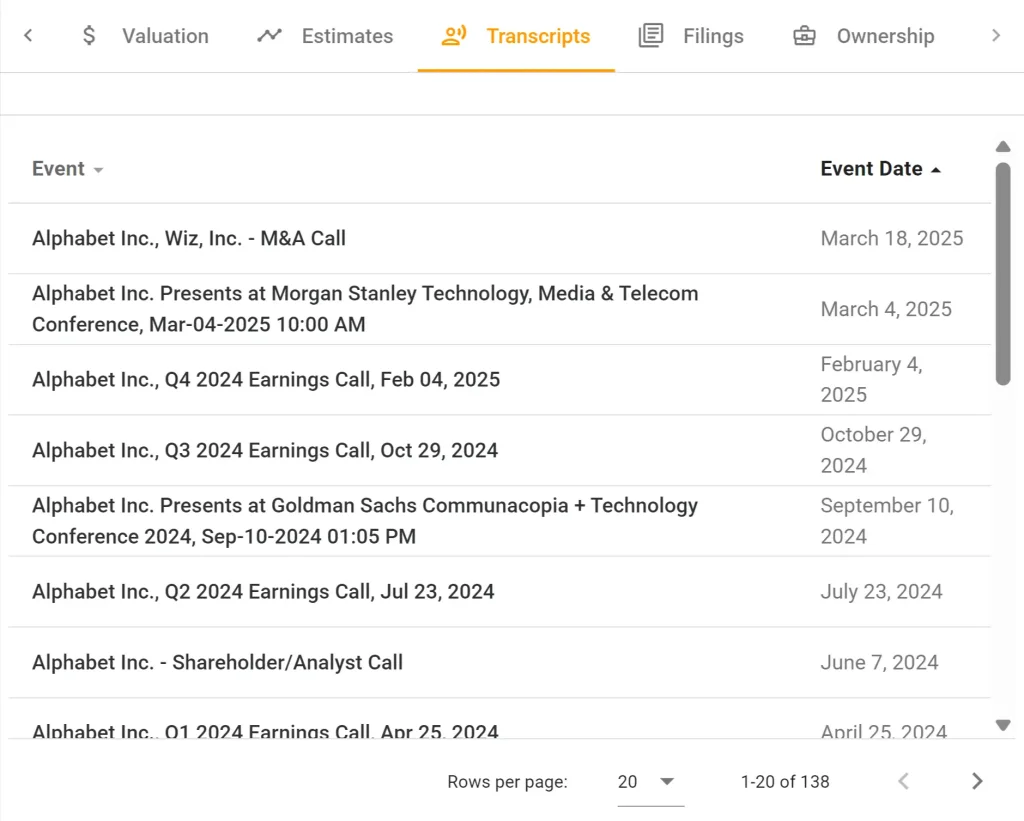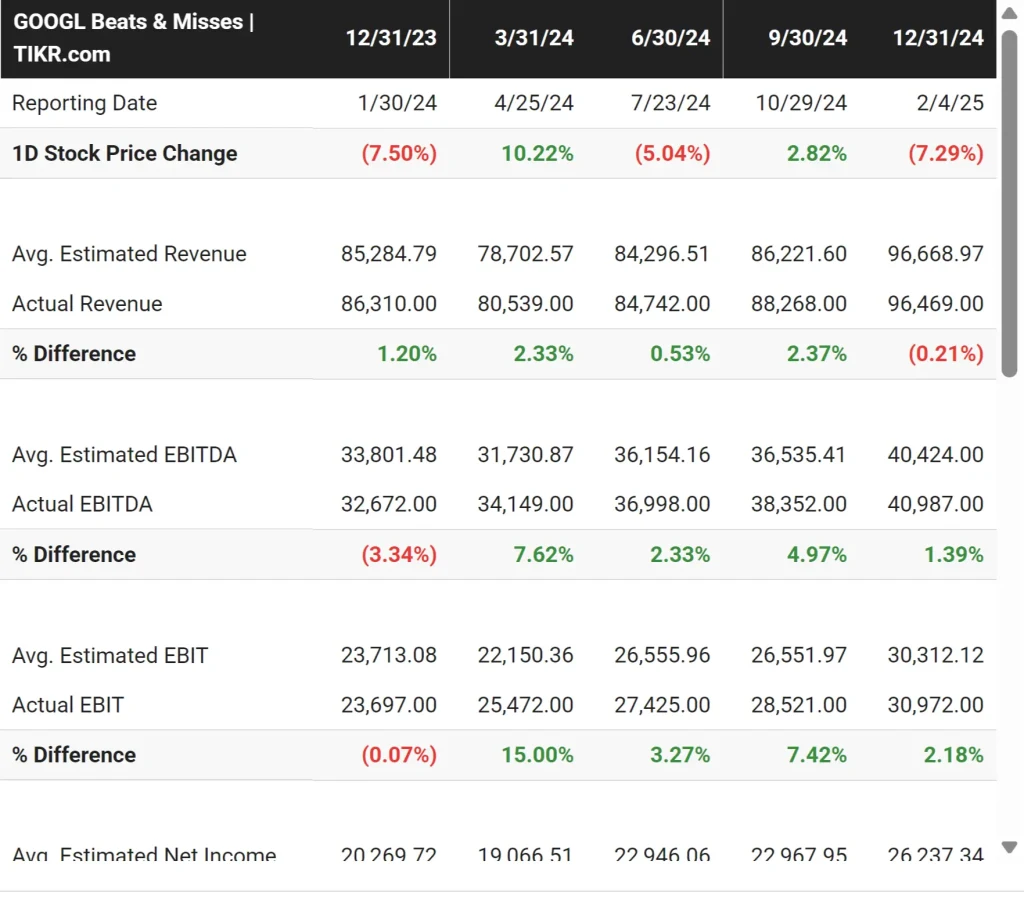Public companies report their financial results once every quarter, which gives investors one of the best opportunities to understand how a stock’s underlying business is performing.
These earnings reports can often cause big moves in stocks, which can lead to stocks rising or crashing after reporting earnings.
In this article, we’ll talk about how to interpret a company’s earnings results, so you’ll be able to gauge whether a business is performing well, facing challenges, or experiencing fundamental changes that could kill the business.
Table of Contents:
- Understanding the Earnings Transcript
- How to Compare Actual Results vs Expected
- Revenue Growth
- Profitability
- EPS and Share Count Trends
- Forward Guidance and Management Outlook
- TIKR Takeaway
Let’s dive in!
1. Understanding the Earnings Transcript
Every quarter, all public companies (like Google or Meta) share their earnings results with the general public in an earnings call.
This is a big deal for investors because a company’s management team comes on the call, shares what’s going on with the business, and takes questions from investment analysts.
Some investors choose to listen in on this call, but for most investors, it’s more convenient to simply read a transcript of everything that was said on the call after the event.
Why are Earnings Transcripts Important?
Earnings transcripts offer insights beyond the raw numbers. They allow investors to hear directly from management about the company’s performance, future outlook, and strategy.
Transcripts can reveal management’s confidence in the business, priorities, and responses to challenges. Earnings transcripts provide context that numbers alone cannot.
How Should Investors Use Transcripts?
It’s generally best to skim through a few recent earnings transcripts for stocks that you’re interested in investing in, and keep up to date with quarterly updates for the stocks that you hold.
Investors can use earnings transcripts to gauge the strength and credibility of the management team by examining how executives discuss successes, address concerns, and respond to analyst questions.
Other key areas to focus on include mentions of new initiatives, market conditions, regulatory impacts, and any shifts in business strategy.
Access Earnings Transcripts for Free on TIKR
TIKR offers free earnings transcripts, so you can quickly understand if a company has a strong management team.
By using TIKR, investors can streamline their research process, compare narratives over time, and make more informed decisions based on a holistic view of a company’s communications.
Access earnings transcripts for free on TIKR >>>

2. Compare Actual Results to Analyst Estimates
Earnings vs. Expectations
The first place to start with a company’s earnings results is to compare the company’s reported numbers against Wall Street’s expectations.
Look at revenue (the “top line”) and earnings per share (EPS), and note whether the company beat, met, or missed consensus estimates.
Even a small earnings beat can move a stock sharply higher, especially if expectations were low or management raises guidance.
TIKR makes it easy to see how a company performed with its Earnings Review feature. You can see that in Q4 of 2024, Google had a small revenue miss and a slight earnings beat:

Analyze any company’s earnings results quicker with TIKR! >>>
Track Beats & Misses Over Time
It can be helpful to track a company’s beats and misses over time so you can identify patterns, like whether a company consistently under-promises and over-delivers.
TIKR lets you quickly see whether a company has beaten or missed estimates for key figures over the past several quarters:

3. Revenue Growth: Top-Line Momentum
Track the Growth Rate
Revenue growth is one of the clearest signs of business growth.
Start by comparing year-over-year (YoY) revenue growth for the quarter. If the company is in a seasonal industry, it’s also helpful to look at quarter-over-quarter (QoQ) growth.
Understand the Drivers
Management will typically explain what’s driving revenue growth.
For example, most management teams will break down revenue growth by business segment, geography, organic vs inorganic growth (underlying business growth vs growth from acquisitions), and whether revenue growth was driven primarily by price or volume increases.
This would help you answer questions like: Is cloud growth still strong at Microsoft? Are international sales slowing at Nike? Is Pepsi’s unit volume growing in North America? Is Sherwin-Williams continuing to implement price increases without too much of a loss in demand?
Management Language to Watch
- Management may highlight “strong demand,” or “record revenues” when topline results are healthy.
- On the flip side, they might cite “macro pressures,” “weaker-than-expected volumes,” or “FX headwinds” if revenue growth stalls.
- If a specific product or geography drove growth, expect callouts like “led by strength in North America” or “driven by cloud momentum.”
4. Profitability: Margins Tell the Story
Track Key Margin Metrics
Profit margins are a powerful way to evaluate the health and efficiency of a business.
In the earnings call, management will typically explain how their gross, operating, and net margins performed for the quarter. This is helpful for investors to get an insight into the business’s cost structure, and how costs might develop in the future.
Gross margin shows how much profit a company keeps after covering its direct costs. A company with strong pricing power or lower input costs will generally report a higher gross margin.
Operating margin accounts for overhead like R&D and sales expenses. This tells you how efficiently the company is scaling its business.
Finally, net margin reflects the company’s bottom-line profitability after interest and taxes.
TIKR makes it easy to track a company’s multi-year margin history and compare it to peers in the industry.
Management Language to Watch
- Look for phrases like “margin expansion,” “operating leverage,” or “improved cost structure” when margins are improving.
- If profitability is under pressure, you might hear “margin compression,” “cost headwinds,” or “higher input costs.”
- Pay attention to how management frames changes. A margin decline paired with investment in future growth is very different from margins falling due to pricing pressure or weak demand.
5. EPS and Share Count Trends
EPS Growth and Consistency
Earnings per share (EPS) remains one of the most closely watched numbers in any earnings release.
You can compare actual EPS to analyst estimates, and look at whether EPS is growing consistently over time.
Also, make sure to review both GAAP and adjusted EPS. Companies sometimes exclude one-time items from adjusted results to give a clearer view of core profitability. Just be aware that some companies stretch this too far.
If adjusted EPS is consistently higher than GAAP, you might want to read the footnotes and understand why.
Track the Share Count
Sometimes, EPS can rise simply because the number of shares falls. This is common when companies repurchase their stock. You can use TIKR to track a company’s diluted shares outstanding and make sure EPS isn’t growing just because of share buybacks.
If a company is issuing a lot of stock, especially to employees or executives, that can dilute shareholders over time.
Tech companies in particular often use stock-based compensation, so keep an eye on whether buybacks are offsetting dilution.
Management Language to Watch
- When EPS is strong, management might mention “record earnings,” “sustainable growth,” or “operating discipline.”
- On calls with weaker EPS, listen for explanations like “non-cash charges” or “temporary items.”
6. Forward Guidance and Management Outlook
What to Watch For
The numbers from the past quarter matter, but what management says about the future often has the biggest impact on the stock’s price.
Most companies issue guidance for revenue, EPS, or margins. Some companies will issue guidance only for next quarter, but many companies issue guidance for the full-year.
A “beat and raise” quarter, where the company exceeds estimates and lifts its full-year outlook, is often viewed positively.
A miss paired with a cut in full-year guidance can really hurt the stock’s share price, especially in the short-term.
Evaluate the Assumptions
Guidance is often based on assumptions about pricing, demand, or macro conditions. Pay attention to what management expects in areas like customer growth, product launches, or inflation.
Management Language to Watch
- Strong guidance might include “raising our full-year outlook,” “continued momentum,” or “robust pipeline.”
- Cautious guidance often comes with phrases like “uncertain macro environment,” “softening demand,” or “recalibrating expectations.”
FAQ Section:
What are the most important numbers to look for in an earnings report?
Some of the most important numbers in an earnings report to focus on are revenue growth, EPS, margins, and forward guidance to assess a company’s performance and future potential.
How do you tell if a company had a good quarter?
Investors can tell if a company had a good quarter by comparing the company’s published results to analyst expectations. If a company beats estimates, it generally had a good quarter.
Why do stocks fall even after beating earnings estimates?
A stock might fall even after beating earnings estimates if the company lowered guidance, margins shrank, or if expectations were already priced in.
What does “margin expansion” mean in an earnings report?
Margin expansion means the company grew profit margins and became more profitable relative to revenue. This is often due to pricing power or better cost control.
How can I use TIKR to analyze earnings results?
TIKR lets you compare actual results to estimates, track multi-year financial trends, and break down key metrics by segment or geography.
TIKR Takeaway
Investors can gain a clear edge in evaluating a company’s performance by knowing how to read a company’s earnings report.
The TIKR Terminal offers industry-leading financial data on over 100,000 stocks, so if you’re looking to find the best stocks to buy for your portfolio, you’ll want to use TIKR!
TIKR offers institutional-quality research for investors who think of buying stocks as buying a piece of a business.
Disclaimer:
Please note that the articles on TIKR are not intended to serve as investment or financial advice from TIKR or our content team, nor are they recommendations to buy or sell any stocks. We create our content based on TIKR Terminal’s investment data and analysts’ estimates. Our analysis might not include recent company news or important updates. TIKR has no position in any stocks mentioned. Thank you for reading, and happy investing!






